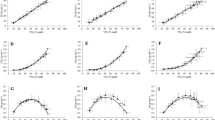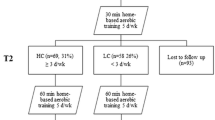Abstract
The aim of this study was to assess the effects on performance and work capacity of a short-term (3-week) integrated body weight reduction programme consisting of an energy-restricted diet, nutritional education, psychological counselling and aerobic exercise training at a constant metabolic load (5 days/week) in 71 severely obese patients (18 males and 53 females aged 29.3±0.8 years, with a mean weight of 113.8±2.2 kg and a mean BMI of 41.3± 0.5 kg/m−2). Body mass and composition, and maximum oxygen consumption (\(\dot VO_2\)max) were determined before and after the programme. The caloric equivalent of work output and a performance index (PI) during 10 min of bicycle ergometer pedalling (50–60 rpm) and 20 min of treadmill walking (incline 0–3%) at a constant metabolic load (50% of individual \(\dot VO_2\)max during the preliminary conditioning period — 1st week- and 60% during the exercise conditioning period — 2nd and 3rd week) were evaluated daily throughout the study. After the programme, body mass reduced significantly (−4.5%, p<0.001), the weight loss being sustained entirely by a significant reduction in fat mass (−7.6%, p<0.001) without any significant changes in fat-free mass. Absolute and body mass-related \(\dot VO_2\)max significantly increased by respectively 14.5% and 20.2% (p<0.001). Both daily work output during constant metabolic load (ANOVA, p<0.05−0.001) and PI (ANOVA, p<0.05−0.001) increased significantly during each week of the programme, leading to a total increase in work output in response to exercise conditioning of 44.6±5.8 kcal. It is concluded that the changes in exercise capacity induced by the present programme offer significant advantages for obese patients that can be quantified in terms of an improvement in their ability to perform everyday activities, thus contributing towards improving their quality of life.
Similar content being viewed by others
References
Vansant G., Hulens M., van der Borght W., Demyttenaere K., Lysens R., Muls E.: A multidisciplinary approach to the treatment of obesity. Int. J. Obes., 23, S65–S68, 1999.
Cowburn G., Hillsdon M., Hankey C.R.: Obesity management by life-style strategies. Br. Med. Bull., 53, 389–408, 1997.
Glenny A.M., O’Meara S., Melville A., Sheldon T.A., Wilson C.: The treatment and prevention of obesity: a systematic review of the literature. J. Obes., 21, 715–737, 1997.
Fairburn C.G., Cooper Z.: New perspectives on dietary and behavioral treatments for obesity. Int. J. Obes., 20, S9–S13, 1996.
Pavlou K.N., Steffee W.P., Lerman N.H., Burrows V.: Effects of dieting and exercise on lean body mass, oxygen uptake, and strength. Med. Sci. Sports Exerc., 17, 466–471, 1985.
Ross R., Rissanen J., Padwell H., Cliffort J., Shragge P.: Influence of diet and exercise on skeletal muscle and adipose tissue in man. J. Appl. Physiol., 81, 2445–2455, 1996.
Food and nutrition board. Summary: weighing the options-criteria for evaluating weight management programs. J. Am. Diet. Assoc., 95, 96–105, 1995.
Sartorio A., Lafortuna C.L., Vangeli V., Tavani A., Bosetti C., La Vecchia C.: Short-term changes of cardiovascular risk factors after a non-pharmacological body weight reduction program. Eur. J. Clin. Nutr., 55, 865–869, 2001.
Kraemer W.J., Volek J.S., Clark K.L., Gordon S.E., Puhl S.M., Koziris L.P., McBride J.M., Triplett-McBride N.T., Putukian M., Newton R.U., Hakkinen K., Bush J.A., Sebastianelli W.J.: Influence of exercise training on physiological and performance changes with weight loss in men. Med. Sci. Sports Exerc., 31, 1320–1329, 1999.
Sartorio A., Lafortuna C.L., Silvestri G., Narici M.V.: Effects of short-term, integrated body mass reduction program on maximal oxygen consumption and anaerobic alactic performance in obese subjects. Diab. Nutr. Metab., 16, 24–31, 2003.
Sartorio A., Lafortuna C.L., Massarini M., Galvani C.: Effects of different training protocols on exercise performance during a short-term body mass reduction program in severely obese patients. Eating Weight Disord., 8, 36–43, 2003.
ACSM’s resource manual for guidelines for exercise testing and prescription, 6th ed. Baltimore, Lippincott, Williams & Wilkins, 2000.
di Prampero P.E., Cortili G., Mognoni P., Saibene F.: Equation of motion of a cyclist. J. Appl. Physiol., 47, 201–206, 1979.
Margaria R.: Sulla fisiologia e specialmente sul consumo energetico della marcia e della corsa a varia velocità ed inclinazione del terreno. Att. Acc. Naz. Lincei 7, 299–368, 1938.
Pugh L.G.C.E.: The influence of wind resistance in running and walking and the mechanical efficiency of work against horizontal and vertical forces. J. Physiol., (Lond.), 213, 255–276, 1971.
Lohran T.G., Roche A.F., Martorell R.: Anthropometric standardisation reference manual. Campaign, Human Kinetics Books, 1988.
Durenberg P.: International consensus conference on impedance in body composition. Age Nutr., 5, 142–145, 1994.
Gaesser G.A., Rich G.A.: Effects of high- and lowintensity exercise on aerobic capacity and blood lipids. Med. Sci. Sports Exerc., 16, 269–275, 1984.
Shephard R.J.: Intensity, duration, and frequency of exercise as determinants of the response to a training regime. Int. Z. Angew. Physiol., 26, 272–281, 1968.
Sartorio A., Narici M.V., Fumagalli E., Faglia G., Lafortuna C.L.: Aerobic and anaerobic performance before and after a short-term body mass reduction program in obese subjects. Diab. Nutr. Metab., 14, 51–57, 2001.
Wilmore J.H, Costill D.L.: Physiology of sport and exercise. Campaign, Human Kinetics Books, 1994.
Lafortuna C.L., Fumagalli E., Vangeli V., Sartorio A.: Lower limb alactic anaerobic power output assessed with different techniques in morbid obesity. J. Endocrinol. Invest., 25, 134–141, 2002.
Sartorio A., Lafortuna C.L., Conte G., Faglia G., Narici M.V.: Changes in motor control and muscle performance after a short-term body mass reduction program in obese subjects. J. Endocrinol. Invest., 24, 393–398, 2001.
Author information
Authors and Affiliations
Corresponding author
Rights and permissions
About this article
Cite this article
Sartorio, A., Ottolini, S., Agosti, F. et al. Three-week integrated body weight reduction programme markedly improves performance and work capacity in severely obese patients. Eat Weight Disord 8, 107–113 (2003). https://doi.org/10.1007/BF03324999
Published:
Issue Date:
DOI: https://doi.org/10.1007/BF03324999




